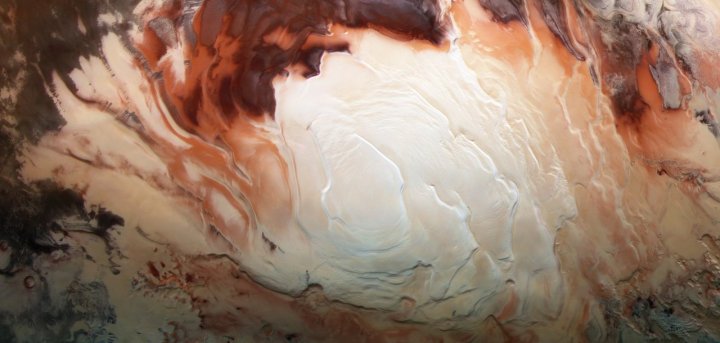
The question of how to access water on Mars is a big one if we eventually want to send a crewed mission there. As far as we can tell, Mars doesn’t have liquid water on its surface now, but it does have large amounts of ice at its poles as well as subsurface ice in other regions. Locating exactly where this subsurface ice is and how accessible it is is a major question to be answered by the upcoming Mars Ice Mapper mission.
Now, a new study using data from an orbiter suggests that there could be large subsurface ‘lakes’ on Mars, although how there could be liquid water in such a cold environment remains unclear.
Researchers used data from Mars Express, the European Space Agency’s orbiter which uses radar as well as a high-definition camera to image the planet. The radar data shows signals around the south pole which suggests the presence of underground lakes. This concept was first floated in 2018, when different researchers used data from the same orbiter to locate the first lake. This new study has found dozens of similar signals.
However, Mars gets very cold and this far south, it is thought to be too cold for water to remain in its liquid form. So it’s not clear how to explain the radar signals.
“We’re not certain whether these signals are liquid water or not, but they appear to be much more widespread than what the original paper found,” said Jeffrey Plaut of JPL, co-principal investigator of the orbiter’s MARSIS (Mars Advanced Radar for Subsurface and Ionospheric Sounding) instrument. “Either liquid water is common beneath Mars’ south pole or these signals are indicative of something else.”
Some of the signals found less than a mile from the surface, where the estimated temperature would be minus 81 degrees Fahrenheit (minus 63 degrees Celsius). At that temperature, the water would be frozen even if it contained salts which lower its freezing temperature. There is a possibility that underground volcanic activity could raise the temperature enough to keep water liquid, although this kind of activity hasn’t yet been identified in the area.
“They found that it would take double the estimated Martian geothermal heat flow to keep this water liquid,” said Aditya Khuller, co-author of the paper. “One possible way to get this amount of heat is through volcanism. However, we haven’t really seen any strong evidence for recent volcanism at the south pole, so it seems unlikely that volcanic activity would allow subsurface liquid water to be present throughout this region.”
The research is published in the journal Geophysical Research Letters.



